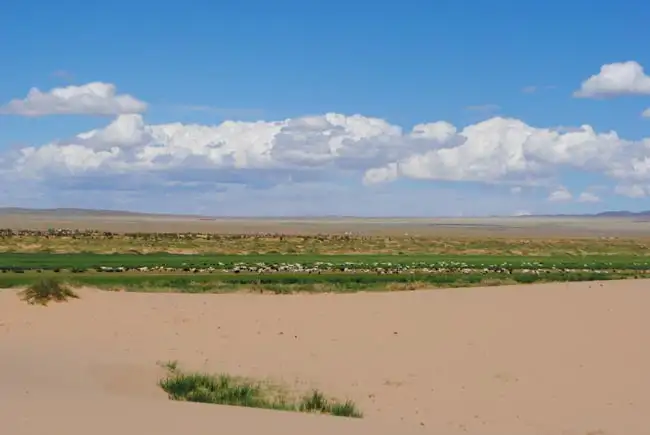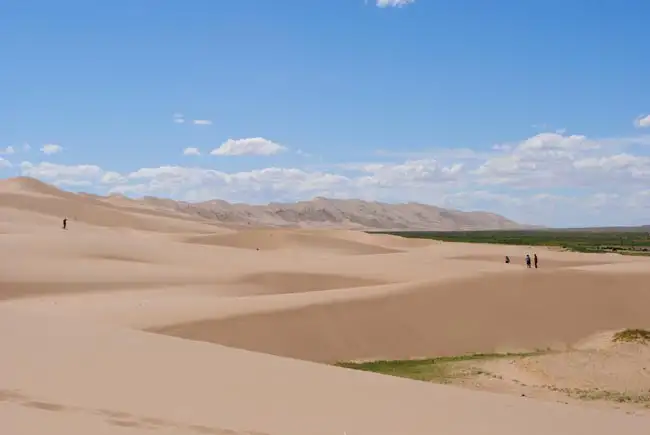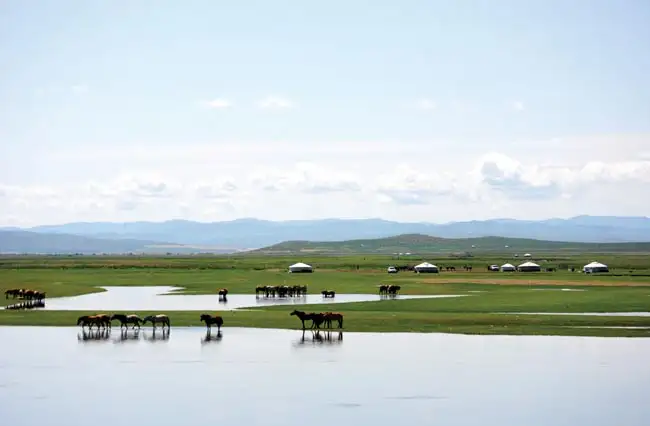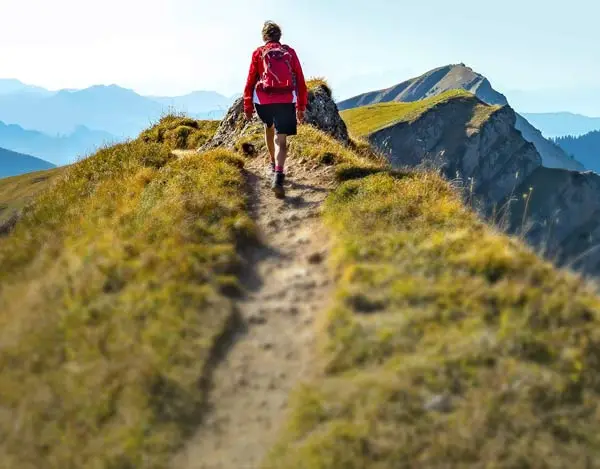- Overview
- Info & Inclusions
- Itinerary
- Map & Hotels
- Photos
- Dates & Prices
- Max Group Size 18
- Remote, exotic, mystical Gobi Desert
- Annua Naadam Festival
- Ancient capital of Karakorum
- Traditional cooking class and evening concert
- Friendly nomadic herds people
- Sleep in a ger!
- Singles friendly (view options for single travellers)
- Full-time Tour Leader with local guide support at various locations.
- Breakfast and dinner daily (at local restaurants and some hotels)
- Lunches are included on all full days.
- All transport, accommodation, sightseeing and entrance fees for sites noted as 'visited' in the detailed itinerary.
- Gratuities for drivers, restaurant staff, porters, local guides.
- Airport transfers for land & air customers and for early arriving/late departing land & air customers who book their extra accommodation through us.
- International airfare to/from the tour.
- Tour Leader gratuities, some lunches, drinks, personal items (phone, laundry, etc), domestic and international (if applicable) air taxes, visa fees, and any excursions referenced as 'optional'.
- Airport transfers for Land Only customers.
- Optional trip cancellation insurance.
- Our post-reservation trip notes offer further guidance on shopping, not included meals, and any locally paid departure taxes.
- Seasonality and Weather:
The best time to travel to Mongolia is from early June through the end of September, when travellers can expect an average range in temperature from 10-26 °C (50 to 80 °F); the Gobi gets hotter, up to 35 °C. Mongolia has approximately 260 cloudless days a year, hence its reputation for endless blue skies.
The rainy season extends from mid-July to August; showers are usually brief but can be heavy. You always should bring some kind of light rain gear. Because Mongolia is located far from any oceans, the humidity is generally very low.
Our annual trip coincides with the annual Naadam Festival. Please note that this event takes places in several locations throughout the country from early July every year, and the exact dates of each locations' version of the Naadam can vary from that of the main event in Ulaanbaatar. As you will see from our detailed itinerary, we choose to attend the Naadam in the Gobi, which usually has dates that vary slightly from Ulaanbaatar - so if you're doing research online, do not panic if you discover a discrepancy! - Transport and Travel Conditions:
In the capital city and surrounding areas, we use buses and minivans as required. Outside of the capital region there are few paved roads; most roads are graded dirt tracks that are often bumpy, and dusty or muddy. Flights via scheduled local carriers.
All efforts are made to ensure that vehicles are in excellent condition, though punctures and weather may cause delays and require patience. Nonetheless such overland expeditions provide the chance to experience the vast landscapes of Mongolia with the flexibility to stop and meet local families along the route.
We have numerous walking tours and visit several sites that are LARGE with steps and uneven surfaces. Porters are generally available at hotels/gers but you must be able to manage with your baggage at airports.
Due to the remote location of most of the ger camps, a general lack of resources, and transportation challenges, travellers with very specific dietary preferences may not be easily accommodated. While vegetarians and those with restrictions that are medically indicated can be catered to if we are advised in advance, we urge all travellers to be flexible and open to the excellent and hearty local fare provided at the camps.
Please note that the overall order of places visited will vary from year-to-year depending on internal air schedules and the location/dates of the Naadaam Festival we intend to experience. A slight shift of dates may be required closer to departure (ie +/- 3 months or more prior), but it is more likely that only the order of places visited will vary within the set dates.
Am I suitable for this tour? Please refer to our self-assessment form - Activity Level: 2
These are particularly busy tours that feature a lot of moving around, sometimes by train and short journeys on local transport. Walking tours of towns and cities are leisurely but you should be prepared to be on your feet for several hours. Some of our cultural trips that occur at high altitude and/or require greater independence with baggage handling (at hotels, airports, train stations) also fall into this category.
To learn more about the Activity levels, please visit our tour styles page. - Accommodation:
We stay at 5-star hotel in Ulaanbataar. At other remote locations, we use very comfortable 'ger' camp accommodation (click on 'Map & Hotels' for full details)
The camps have a maximum capacity of about 20 guests in double occupancy gers that are fully collapsible, and all feature en suite toilet and bath (some online information and reviews may reference central toilets - all of our gers are upgraded to include en suite throughout by 2017). A stove is placed in the middle of each ger and the staff will attend to it in order to provide warmth on cool nights. Towels are provided.
Soft drinks, wine and bottled water are available for purchase from the camps. The camp can be relocated leaving no more impact on the area than a herdsman family would. Solar panels and windmills generate some electricity for refrigerator and kitchen use. - Staff and Support:
Tour Leader throughout, local drivers, local guides at various locations. - Group Size:
Maximum 18 plus Tour Leader
- Day 1:Arrival in UlaanbaatarWelcome to Mongolia. Today we arrive in Ulaanbaatar, capital of this landlocked nation that stretches across the Central Asian plateau between Russia and China. Mongolia's vast territory—larger than Western Europe—contains extraordinary diversity of landscape, from grassland steppes to the Gobi Desert, inhabited by nomadic herders whose way of life remains largely unchanged since the days of Genghis Khan's empire.
Ulaanbaatar, the capital, holds approximately 45% of Mongolia's 3.2 million people. The city has grown rapidly as rural Mongolians migrate here seeking work, particularly after harsh winters kill livestock. Traditional ger districts spread across the hillsides surrounding the modern city centre, where recent migrants live alongside established working-class families. Despite rapid development, Mongolians maintain deep attachment to their nomadic heritage and the open landscapes beyond the city.
This evening we gather with fellow travellers for our first meal together.
Overnight in Ulaanbaatar.
Included Meal(s): Dinner, if required - Day 2:Ulaanbaatar City TouringThis morning we visit Gandan Monastery, seat of Buddhism in Mongolia. The monastery houses a 26-metre (85-foot) gilded Buddha statue and approximately 150 resident monks who conduct daily ceremonies. You may observe morning chants and rituals. Gandan survived Stalin's purges of the 1930s—when most Mongolian monasteries were destroyed—because Soviet authorities maintained it as a showcase for foreign visitors. The name roughly translates as "the great place of complete joy."
We continue to the National Museum of Mongolia, which displays traditional clothing, weaponry, and exhibits chronicling Genghis Khan's empire-building campaigns across Asia. At Sukhbaatar Square, the city's main plaza, statues honour Genghis Khan and Damdin Sukhbaatar, heroes of Mongolian independence.
After lunch at a local restaurant, we visit Bogd Khan Palace Museum, the former winter residence of Mongolia's last theocratic ruler, and Buddha Park.
Overnight in Ulaanbaatar.
Included Meal(s): Breakfast, Lunch and Dinner - Day 3:Ulaanbaatar - the Ancient Capital KarakorumWe travel north through the green grasslands of central Mongolia toward Karakorum. En route we stop at a nomadic family's camp to observe traditional dairy production, including airag—fermented mare's milk, a staple of nomadic diet. Approximately half of Mongolia's population still follows nomadic herding traditions, moving their ger camps several times annually to find fresh pasture. The harsh continental climate makes winter survival challenging, and in recent years severe winters have driven many herders to abandon nomadic life for the capital.
The nomadic lifestyle requires remarkable resilience and self-sufficiency. Families produce their own dairy products, tend livestock, and maintain deep knowledge of weather patterns and grazing lands passed down through generations. Summer brings relative prosperity with abundant grass and mild weather, while winter tests survival skills as temperatures plunge to -40 degrees Celsius.
We reach Kharkhorin village by early evening.
Overnight in Kharkhorin.
Included Meal(s): Breakfast, Lunch and Dinner - Day 4:Karakorum TouringKarakorum occupies a site possibly settled as early as 750 CE. In 1220 Genghis Khan established his military headquarters here as a base for invading China. Though relatively small, Karakorum became one of the Silk Road's most important cities when Genghis Khan's son Ogedei developed it as the Mongol Empire's capital in the 1230s.
We visit Erdene Zuu Monastery, founded in 1586 as central Mongolia's first Buddhist monastery. The complex, built partly from stones salvaged from ancient Karakorum's ruins, survived various destructions to remain an active religious site. The monastery's white walls and stupas contrast dramatically with the surrounding steppe.
This afternoon we visit the Karakorum Museum, which provides context for understanding central Mongolia's history and the UNESCO-protected Orkhon River Valley. Archaeological displays include artifacts from the ancient capital's heyday when it served as the hub of the vast Mongol Empire.
This evening you'll observe preparation of khorkhog, a traditional Mongolian dish cooked with hot stones placed inside a sealed container with meat and vegetables.
Overnight in Kharkhorin.
Included Meal(s): Breakfast, Lunch and Dinner - Day 5:Karakorum - Mongol Nomadic Heritage Camp (Via Hustai National Park)We travel toward Hustai National Park, stopping for lunch at a ger camp en route. Along the way we pause at Elsen Tasarkhai, where rocky mountains, grasslands, lakes and sand dunes converge in an unusual concentration of landscapes.
The Mongolian government designated Hustai as a Specially Protected Area in 1993 following reintroduction of Przewalski's horse (takhi), a rare wild horse subspecies that had become extinct in the wild. The park covers over 50,000 hectares and supports diverse wildlife including Mongolian gazelle, wild sheep, ibex, marmots, and over 215 bird species. UNESCO recognized Hustai as a biosphere reserve in 2002.
At the park's information centre we watch a documentary about conservation efforts and the takhi horses. We then explore the surrounding area on foot, hoping to observe these stocky wild horses and other wildlife in their natural habitat. The takhi, with their distinctive dun colouring and upright manes, represent successful international cooperation in wildlife conservation.
Overnight at Hustai National Park.
Included Meal(s): Breakfast, Lunch and Dinner - Day 6:Terelj National ParkThis morning we drive to Terelj National Park, stopping en route at the giant Genghis Khan statue at Tsonjin Boldog. According to legend, Genghis Khan found a golden whip at this spot beside the Tuul River. Erected in 2008, the statue depicts Genghis Khan on horseback, standing 40 metres (131 feet) tall and wrapped in 250 tonnes of stainless steel. To Mongolians, Genghis Khan represents national identity—the unifier of warring tribes, founder of the Mongol Empire that became history's largest contiguous land empire, and reviver of Silk Road trade.
Terelj, Mongolia's third-largest protected area, combines dramatic rock formations with forested valleys. After lunch at a ger camp, we participate in a traditional archery session with local instructors. Archery, along with wrestling and horse racing, forms one of Mongolia's "Three Manly Skills" celebrated at Naadam festivals.
We visit Turtle Rock, a natural granite formation resembling a turtle, and the Meditation Temple perched on rocky heights. We enjoy walks through the surrounding wilderness, where granite formations rise from pine-covered slopes.
Overnight at Terelj Lodge.
Included Meal(s): Breakfast, Lunch and Dinner - Day 7:Terelj - Ulaanbaatar TouringThis morning we return to Ulaanbaatar to visit the newly opened Genghis Khan Museum. The museum's exhibits trace the rise of the Mongol Empire through artifacts, maps, and displays explaining the military innovations and administrative systems that allowed Mongol forces to conquer territory from Eastern Europe to the Pacific Ocean.
After lunch at a local restaurant, we visit the Zanabazar Museum of Fine Arts, named for Mongolia's greatest sculptor and first spiritual leader. The collection includes Buddhist art, traditional paintings, and contemporary Mongolian works. The museum provides insight into artistic traditions that flourished even during periods of political upheaval.
Late afternoon is free to rest at the hotel or explore Ulaanbaatar independently.
Overnight in Ulaanbaatar.
Included Meal(s): Breakfast, Lunch and Dinner - Day 8:Flight to the Gobi Desert - Yoliin Am Gorge & Khavtsgait PetroglyphsAfter breakfast we fly south to the Gobi Desert. The Gobi covers much of southern Mongolia—contrary to popular imagination, sand dunes occupy only about 3% of this vast region. Most of the Gobi consists of gravel plains, rocky outcrops, and sparse grassland supporting scattered nomadic herders. The word "Gobi" refers to a shallow basin, and this desert creates its own weather systems, receiving minimal rainfall but experiencing extreme temperature swings between seasons.
Upon arrival we drive to Yoliin Am, a dramatic gorge cutting through the Gurvan Saikhan Mountains (the "Three Beauties"). The gorge was established initially to protect local bird populations but has gained fame for its shaded canyon where ice persists into summer despite the desert heat. Eagles circle overhead hunting for prey, while nomadic families gather at scattered wells below.
We walk through the narrow gorge hoping to spot wildlife—lammergeiers, ibex, and argali sheep frequent these cliffs. On our return we stop at Khavtsgait to see ancient petroglyphs carved into rock faces, depicting hunting scenes and animals from thousands of years ago.
Overnight at Dream Gobi Camp.
Included Meal(s): Breakfast, Lunch and Dinner - Day 9:Naadam Festival in the Gobi DesertAfter breakfast we travel to the local Naadam Festival venue (approximately one hour) to experience a full day of Mongolia's greatest celebration. The festival centres on the "Three Manly Skills"—wrestling, horse racing, and archery—along with ankle bone shooting, a traditional game using sheep knucklebones.
Naadam has roots in assemblies held by Mongol armies and nomadic wedding celebrations. Today it remains Mongolia's most important holiday, drawing families from across the countryside. People wear their finest traditional clothing—silk deels for women, boots with upturned toes, and elaborate headdresses. The atmosphere combines athletic competition with social gathering, music, and feasting.
Wrestling matches follow ancient rules with no weight classes or time limits—matches end only when one competitor's shoulder, elbow, or knee touches ground. Young riders race horses across open steppe, some as young as five years old. Archers use traditional recurve bows, aiming at leather targets from prescribed distances.
Beyond the formal competitions, the festival grounds offer food stalls, craft vendors, and impromptu gatherings where Mongolians socialize, sing traditional songs, and celebrate their heritage.
NOTE: Naadam operates on flexible scheduling rather than strict timetables. Our local guide will adapt our program to maximize the experience as events unfold.
Overnight at Dream Gobi Camp.
Included Meal(s): Breakfast, Lunch and Dinner - Day 10:Khongor Sand Dunes & OasisThis morning we drive to Khongor Sand Dunes, Mongolia's largest sand formation stretching over 180 kilometres (112 miles) through the Gobi. Also called Duut Mankhan (Singing Dunes), these isolated dunes produce distinctive sounds when wind moves the sand or small avalanches occur on the steep faces.
Our route crosses vast desert badlands where remote mountains line distant horizons. We stop frequently for photographs of the dramatic landscapes and any nomadic families we encounter. At the dunes we visit a nomadic camel herder's family and enjoy a short camel ride (approximately 30 minutes) on Bactrian camels—the two-humped variety adapted to extreme desert conditions.
After lunch at a ger camp near the dunes, you have free time to climb the dunes, explore the surrounding area, or simply experience the profound silence of the desert. The dunes rise up to 200 metres (656 feet) high, and climbing to their crests requires effort in loose sand but rewards with sweeping views across the Gobi.
We return to Dream Gobi Camp for dinner.
Overnight at Dream Gobi Camp.
Included Meal(s): Breakfast, Lunch and Dinner - Day 11:Cooking Class & Bayanzag Flaming CliffsAfter breakfast we visit a nomadic family for a traditional cooking class lasting approximately three hours. We learn to prepare steamed meat dumplings (buuz) and either potato salad or noodle soup, gaining insight into nomadic food culture and the practical challenges of cooking in a ger with limited resources. The experience offers genuine interaction with a nomadic family and understanding of daily life in the Gobi.
Following our class we watch a documentary about Bayanzag, then drive 45 minutes to the Flaming Cliffs. American explorer Roy Chapman Andrews discovered dinosaur eggs here in the 1920s during expeditions that captured international attention. The exposed sedimentary cliffs, glowing orange-red in sunlight, date to the Cretaceous period and continue yielding fossils. The site's stark beauty—eroded formations rising from flat desert—makes it one of the Gobi's most photogenic locations.
We explore the area on foot, with time to wander among the formations and through the scattered saxaul forest, a hardy desert tree that provides crucial habitat for wildlife.
Overnight at Dream Gobi Camp.
Included Meal(s): Breakfast, Lunch and Dinner - Day 12:The Gobi Museum and Flight to UlaanbaatarAfter breakfast and some leisure time at camp, we visit the Gobi Museum, which displays local natural history, paleontology specimens, and exhibits on traditional life in the desert regions. The museum provides context for understanding the geology, wildlife, and human adaptation to this extreme environment.
Following lunch we transfer to the airport for our late afternoon flight back to Ulaanbaatar. The flight crosses hundreds of kilometres of desert and steppe, offering aerial perspective on Mongolia's vast, sparsely populated landscape.
Upon arrival in Ulaanbaatar, we gather for our farewell dinner, reflecting on our journey from capital to desert, from ancient Karakorum to contemporary nomadic life.
Overnight in Ulaanbaatar.
Included Meal(s): Lunch - Day 13:DepartureDeparture from Ulaanbaatar.
Bon voyage! Bayartai!
Included Meal(s): Breakfast
Countries Visited: Mongolia
*The red tour trail on the map does not represent the actual travel path.
















Book This Tour
- Final payment: Due 90 days prior to departure.
- Deposit: A non-refundable $500 CAD Deposit is required at booking.
- Optional Single Supplement: $1690 CAD (number of singles limited).
(View options forsingle travellers) - Transfering Tour or Date: Transferring to another tour or tour date is only permissible outside of 120 days prior to departure and is subject to a $100 CAD change fee.
(Read our cancellation policy) - If you're booking more than a year in advance, PLEASE NOTE that our dates may shift slightly due to ever-changing internal air schedules and festival dates.
Prices below are per person, twin-sharing costs in Canadian Dollars (CAD). Pricing does not include airfare to/from the tour and any applicable taxes.
Frequently Asked Questions
- What is the maximum number of participants on a trip?Most of our tours carry a maximum of 18 participants; some tours (ie hiking tours) top out at 16. In the event that we do not achieve our minimum complement by our 90-day deadline, we may offer group members the option of paying a "small-group surcharge" as an alternative to cancellation. If all group members agree, we will confirm the trip at existing numbers; this surcharge is refundable in the event that we ultimately achieve our regular minimum. If the small group surcharge is not accepted, we will offer a refund of your deposit or a different trip of your choice.
- Can I extend my tour either at the beginning or end? What about stopovers?Yes, you can extend your tour either at the beginning or the end and we can book accommodation in our tour hotel. Stopovers are often permitted, depending on air routing. Stopovers usually carry a "stopover" fee levied by the airline.
- How do I make a reservation? How and when do I pay?The easiest way to make a reservation is via our website; during office hours, you are also more than welcome to contact us by telephone.
A non-refundable deposit is payable at the time of booking; if a reservation is made within 90 days, full payment is required. Some trips require a larger deposit. If international airline bookings require a non-refundable payment in order to secure space or the lowest available fare, we will require an increase in deposit equal to the cost of the ticket(s).
Early enrolment is always encouraged as group size is limited and some trips require greater preparation time.
Once we have received your deposit, we will confirm your space and send you a confirmation package containing your trip itinerary, any visa/travel permit related documents, invoice, clothing and equipment recommendations, general information on your destination(s), and forms for you to complete, sign and return to us. Your air e-tickets (if applicable), final hotel list, final trip itinerary, and instructions on how to join your tour, will be sent approximately 2-3 weeks prior to departure. - What about cancellations, refunds, and transfers?Please review our cancellation policy page for details.
- I am a single who prefers my own room. What is a single supplement?All of our tours have a single supplement for those who want to be guaranteed their own room at each location.
This supplement is a reflection of the fact that most hotels around the world do not discount the regular twin-share rate for a room by 50% for only one person occupying a room. Most hotels will give a break on the price, but usually in the range of 25-30% of the twin-share rate. This difference, multiplied by each night, amounts to the single supplement.
The conventional amount can also vary from country to country and some destinations are more expensive than others for single occupancy. In order to be "single friendly," the supplements we apply are not a profit centre for us and we do our best to keep them as reasonable as possible.
On most tours we limit the number of singles available, not to be punitive, but rather because many hotels allow for only a limited number of singles; some smaller hotels at remote locations also have a limited number of single rooms available.
Please note that most single rooms around the world are smaller than twin-share rooms and will likely have only one bed. - Do you have a shared accommodation program?Yes! If you are single traveller and are willing to share, we will do our best to pair you with a same-gender roommate. On most of our tours, if we fail to pair you, we will absorb the single supplement fee and you will default to a single room at no extra charge. At some destinations, however, where single rooms are not significantly discounted, or not at all, we may apply a "mandatory" single in the event that we cannot find you a share partner. This is usually 50% of the usual supplement, but can be as much as 100%. If applicable, this proviso will be noted on each tour page on this website, on your invoice, and in our tour date/price book (available for download under "Resources").
